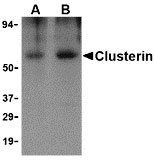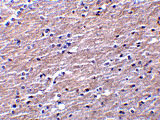Clusterin Antibody
- 产品详情
- 实验流程
- 背景知识
Application
| WB, E, IHC-P |
|---|---|
| Primary Accession | P10909 |
| Other Accession | NP_001822, 42716297 |
| Reactivity | Human |
| Host | Rabbit |
| Clonality | Polyclonal |
| Isotype | IgG |
| Calculated MW | 52495 Da |
| Concentration (mg/ml) | 1 mg/mL |
| Conjugate | Unconjugated |
| Application Notes | Clusterin antibody can be used for the detection of Clusterin by Western blot at 0.5 - 1 µg/mL. Antibody can also be used for immunohistochemistry starting at 10 µg/mL. |
| Gene ID | 1191 |
|---|---|
| Other Names | Clusterin Antibody: CLI, AAG4, APOJ, CLU1, CLU2, KUB1, SGP2, APO-J, SGP-2, SP-40, TRPM2, TRPM-2, NA1/NA2, CLI, Clusterin, Aging-associated gene 4 protein, Apo-J, clusterin |
| Target/Specificity | CLU; |
| Reconstitution & Storage | Clusterin antibody can be stored at 4℃ for three months and -20℃, stable for up to one year. As with all antibodies care should be taken to avoid repeated freeze thaw cycles. Antibodies should not be exposed to prolonged high temperatures. |
| Precautions | Clusterin Antibody is for research use only and not for use in diagnostic or therapeutic procedures. |
| Name | CLU (HGNC:2095) |
|---|---|
| Function | [Isoform 1]: Functions as extracellular chaperone that prevents aggregation of non native proteins (PubMed:11123922, PubMed:19535339). Prevents stress-induced aggregation of blood plasma proteins (PubMed:11123922, PubMed:12176985, PubMed:17260971, PubMed:19996109). Inhibits formation of amyloid fibrils by APP, APOC2, B2M, CALCA, CSN3, SNCA and aggregation-prone LYZ variants (in vitro) (PubMed:12047389, PubMed:17407782, PubMed:17412999). Does not require ATP (PubMed:11123922). Maintains partially unfolded proteins in a state appropriate for subsequent refolding by other chaperones, such as HSPA8/HSC70 (PubMed:11123922). Does not refold proteins by itself (PubMed:11123922). Binding to cell surface receptors triggers internalization of the chaperone-client complex and subsequent lysosomal or proteasomal degradation (PubMed:21505792). Protects cells against apoptosis and against cytolysis by complement: inhibits assembly of the complement membrane attack complex (MAC) by preventing polymerization of C9 pore component of the MAC complex (PubMed:2780565, PubMed:1903064, PubMed:2601725, PubMed:2721499, PubMed:1551440, PubMed:9200695, PubMed:34667172). Intracellular forms interact with ubiquitin and SCF (SKP1-CUL1-F-box protein) E3 ubiquitin-protein ligase complexes and promote the ubiquitination and subsequent proteasomal degradation of target proteins (PubMed:20068069). Promotes proteasomal degradation of COMMD1 and IKBKB (PubMed:20068069). Modulates NF-kappa-B transcriptional activity (PubMed:12882985). A mitochondrial form suppresses BAX-dependent release of cytochrome c into the cytoplasm and inhibit apoptosis (PubMed:16113678, PubMed:17689225). Plays a role in the regulation of cell proliferation (PubMed:19137541). An intracellular form suppresses stress-induced apoptosis by stabilizing mitochondrial membrane integrity through interaction with HSPA5 (PubMed:22689054). Secreted form does not affect caspase or BAX- mediated intrinsic apoptosis and TNF-induced NF-kappa-B-activity (PubMed:24073260). Secreted form act as an important modulator during neuronal differentiation through interaction with STMN3 (By similarity). Plays a role in the clearance of immune complexes that arise during cell injury (By similarity). |
| Cellular Location | [Isoform 1]: Secreted. Note=Can retrotranslocate from the secretory compartments to the cytosol upon cellular stress. [Isoform 6]: Cytoplasm. Note=Keeps cytoplasmic localization in stressed and unstressed cell. |
| Tissue Location | Detected in blood plasma, cerebrospinal fluid, milk, seminal plasma and colon mucosa. Detected in the germinal center of colon lymphoid nodules and in colon parasympathetic ganglia of the Auerbach plexus (at protein level). Ubiquitous. Detected in brain, testis, ovary, liver and pancreas, and at lower levels in kidney, heart, spleen and lung. |
For Research Use Only. Not For Use In Diagnostic Procedures.
Provided below are standard protocols that you may find useful for product applications.
BACKGROUND
Clusterin Antibody: Clusterin, also known as Apolipoprotein J (ApoJ), is a ubiquitous multifunctional glycoprotein that can interact with a broad spectrum of molecules such as complement components, various receptors, and the Alzheimer's b-amyloid peptide. Clusterin expression is increased in Alzheimer's disease brain tissue and clusterin-immunoreactive amyloid plaques are found associated with phospho-tau-positive dystrophic neurites and it has been suggested that clusterin facilitates the conversion of diffuse b-amyloid deposits into amyloid and enhances tau phosphorylation in neurites around these plaques. Other reports show that clusterin expression is decreased in proliferating cells and is upregulated in quiescent and senescent cells, suggesting that it may also play a role in aging and tumorigenesis suppression. Clusterin exists in at least two distinct isoforms.
REFERENCES
Calero M, Rostagno A, Frangione B, et al. Clusterin and Alzheimer’s disease. Subcell. Biochem. 2005; 38:273-98.
Martin-Rehrmann MD, Hoe HS, Capuani EM, et al. Association of apolipoprotein J-positive β-amyloid plaques with dystrophic neurites in Alzheimer’s disease brain. Neurotox. Res. 2005; 7:231-42.
Trougakos IP and Gonos ES. Clusterin/Apolipoprotein J in human aging and cancer. Int. J. Biochem. Cell Biol. 2002; 34:1430-48.
Martinon F and Tschopp J. NLRs join TLRs as innate sensors of pathogens. TRENDS Imm. 2005; 26:447-54.
终于等到您。ABCEPTA(百远生物)抗体产品。
点击下方“我要评价 ”按钮提交您的反馈信息,您的反馈和评价是我们最宝贵的财富之一,
我们将在1-3个工作日内处理您的反馈信息。
如有疑问,联系:0512-88856768 tech-china@abcepta.com.























 癌症的基本特征包括细胞增殖、血管生成、迁移、凋亡逃避机制和细胞永生等。找到癌症发生过程中这些通路的关键标记物和对应的抗体用于检测至关重要。
癌症的基本特征包括细胞增殖、血管生成、迁移、凋亡逃避机制和细胞永生等。找到癌症发生过程中这些通路的关键标记物和对应的抗体用于检测至关重要。 为您推荐一个泛素化位点预测神器——泛素化分析工具,可以为您的蛋白的泛素化位点作出预测和评分。
为您推荐一个泛素化位点预测神器——泛素化分析工具,可以为您的蛋白的泛素化位点作出预测和评分。 细胞自噬受体图形绘图工具为你的蛋白的细胞受体结合位点作出预测和评分,识别结合到自噬通路中的蛋白是非常重要的,便于让我们理解自噬在正常生理、病理过程中的作用,如发育、细胞分化、神经退化性疾病、压力条件下、感染和癌症。
细胞自噬受体图形绘图工具为你的蛋白的细胞受体结合位点作出预测和评分,识别结合到自噬通路中的蛋白是非常重要的,便于让我们理解自噬在正常生理、病理过程中的作用,如发育、细胞分化、神经退化性疾病、压力条件下、感染和癌症。







